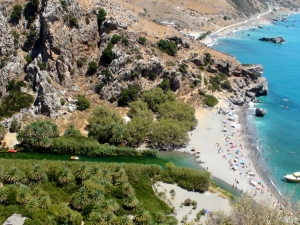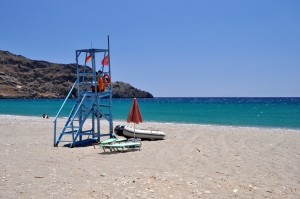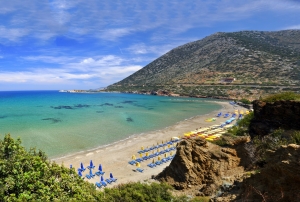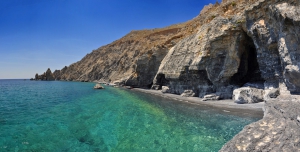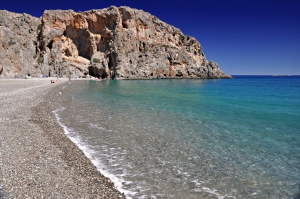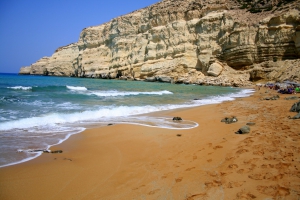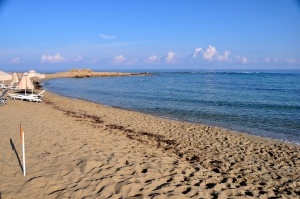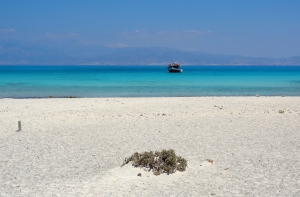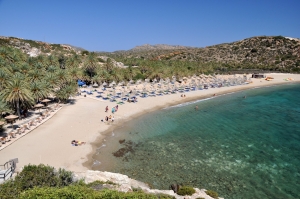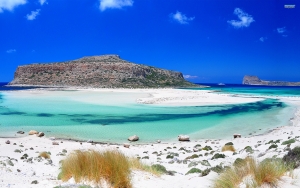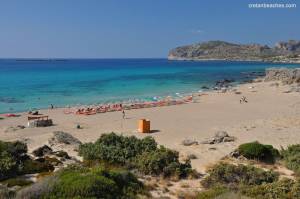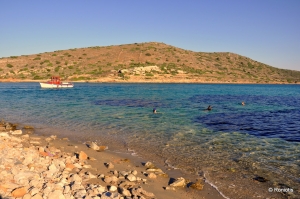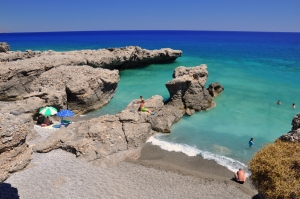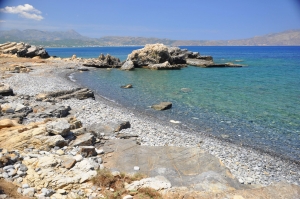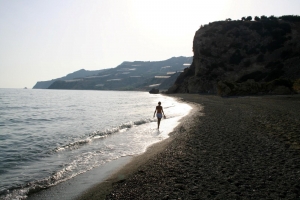It is certainly the most famous beach in southern Crete, accepting thousands of visitors every summer. During the 60s and 70s, it was a favorite destination for hippies. On the banks of the Grand River, there is a large colony of Theophrastus palm trees, which give the region a sense of an African landscape.
Plakias is a popular tourist resort, located 36km south of Rethymno city, at the exit of a fertile valley surrounded by high mountains and dense olive groves. Next to it empties the river Kotsifos.
Bali has four beaches, which are formed in sandy coves with nice greenish waters. The beaches are almost always calm since the direction of Bali is western. They all are suitable for children and well organized. Moreover, water is cool because of the several springs that carry fresh water into the sea.
The majestic black beach of Aspes is located about 58km south of Heraklion, in one of the most remote and inaccessible areas of Asteroussia Mountains. It is situated 4km east of the hamlet of Treis Ekklisies.
To get there you must either cross the gorge, by easy hiking of about 30-50’, or catch a boat from Matala, Agia Galini, or Kali Limenes. We definitely recommend the first option, as the route within the vertical walls of the gorge is breathtaking. On the way you will see the large caves were some hermits still live and the chapel of St. Anthony, with a well outside.
The Red Beach is located at location Moudia, 68km southwest of Heraklion and just 800m south of Matala famous resort. To get here you have to walk a trail that begins north of the settlement of Matala and crosses the hill north of Matala. There used to be some signs showing the way.
The first beach you come across east of the port of Hersonissos is a long sandy narrow beach, which is flooded by thousands of people. It is very well organized and close to the amenities of the city. However, it is inappropriate for those who do not like crowds.
Potamos is a long sandy beach, very well organized, but less crowded than the main beach of Malia. The region, particularly its east part, is not developed due to the archaeological site. However, in the west of the beach, there are several hotels with small bays in front of them.
The thousands of visitors arriving daily by boat from Ierapetra to Chrissi island mainly swim on the beach of Belegrina or Golden Beach. Bright blue waters, white sand with pink shades from the thousands of broken shells, and the junipers that hold the sand with their huge roots are the backdrop that makes anyone fall in love with this place.
In front of the touristic settlement, there is a nice sandy beach with turquoise waters. The sea surface is mainly flat because the beach has an easterly orientation. while winds in Crete come mainly from the west. The beach is organized with umbrellas, sunbeds, and water sports.
Vai was totally unknown until the early 1970s, when a popular commercial for the Bounty chocolate with coconut was filmed here, using the magical background of palm trees. In the advert, coconuts were falling from trees, however Vai palms produce dates. Consequently coconuts had to be falsely hung to create the right impression. The ad made this unknown earthly paradise renowned throughout the world.
The famous lagoon of Balos is located approximately 56km northwest of Chania and 17km northwest of Kissamos, formed between the Cape Gramvousa and the small Cape Tigani. Balos is surely the mostly photographed beach in Crete, a very favorite subject of all tourist guides for Greece. It is no coincidence that Prince Charles and Princess Diana visited Balos on their private yacht many years ago.
The exotic beach of Falassarna is located 59km west of Chania and 17km west of Kissamos. It’s located in the western part of Cape Gramvousa. At the northern end of the beach are the ruins of the ancient Roman city of Falassarna.
The history of Spinalonga is well known to most of us, but what is really unknown is that there is a beautiful beach to enjoy a cooling bath, on the southwest part of the island. The visitor can relax below the several tamarisk trees on the beach and swim with the amazing backdrop of the fortress and the views to the opposite peninsula of Kolokitha.
If you head east of Fylaki beach, you will soon (100m only) reach the exit of the Sfakiano Gorge, with a nice pebbly beach formed. The area is called Plakakia and hosts some of the most spectacular beaches in Crete, formed on small narrow fjords. Indeed, some of them are formed inside small caves! There is a tricky dirt road leading close to the beach.
2km east of Nopigia we meet the rocky coast of Choni. In order to access it, you have to follow the seaside road from Nopigia to the East. After the little square theater of the Orthodox Academy, follow the dirt road leading to Choni and the church of Panagia (i.e. Santa Maria).
Vlites beach is a well protected beach in the large bay of Souda, about 5 km east of Chania city, and is the longest beach of the bay. It is actually the long beach formed north of the mouth of the Moronis River and reaches north to the Souda War Cemetery.
Half a kilometer to the west of Rodakino's main beach, Korakas, we meet the beach of Polirizos, surrounded by dense olive groves. To get here, you have to follow the paved road leading west from Korakas, along the shore.
Vourdolakos or Chlia is a remote beautiful beach with coarse gray sand formed behind the rock of Psaroharako and stretching west to Sidonia. Actually, Vourdolakos consists of several consecutive bays, separated by short rocky parts, where one could snorkel.
The part of the beach west of Listis to the river Anapodaris is called Kamboula. The river is one of the most important Cretan wetlands. The long beach Kamboula is very beautiful, with lovely pebbles and crystal blue waters. This area is no organized, however a very few rooms and apartments have been built in the last years.










